Brazilian office for SNPTC
29 August 2013
China's State Nuclear Power Technology Corp (SNPTC) has set up its first South American office in Rio de Janeiro, Brazil.
 |
| Consul general Chen Xiaoling congratulates SNPTC's Shen Weidong (Image: SNPTC) |
The office was formally inaugurated by Chinese consul general Chen Xiaoling and Shen Weidong, the head of SNPTC's Brazilian delegation, at a ceremony attended by diplomats and representatives of Chinese businesses, enterprises and financial institutions. At the ceremony, Chen Xiaoling said that she hoped the office would enrich and enhance the level of bilateral cooperation between the two nations.
China has developed its own indigenous reactor designs taking as a starting point the reactors built there by overseas suppliers. Two Chinese-designed CNP-300 PWRs are currently under construction at Chashma in Pakistan, and Chen Xiaoling pointed to the "broad prospects for cooperation" in various fields already enjoyed by those two countries.
SNPTC was set up in 2004 to take charge of technology selection for new plants being bid from overseas, and has extensive overseas partnerships, notably with Westinghouse. Together the two companies are working on the construction of four Westinghouse-supplied AP1000 reactors at Haiyang 1 and 2 and Sanmen 1 and 2, the first of a fleet of AP1000 reactors planned for China. Technology transfer to general contractor SNPTC has formed a major part of the project, and the company is involved in the development of the CAP1400 reactor with a view to the export market.
Brazil's two nuclear reactors at Angra currently provide around 3% of its electricity, and a third unit is under construction at the site. Looking further ahead, state nuclear company Eletronuclear is considering building two new four-unit plants, although construction is not likely to start before 2020. No design has been chosen yet, although Westinghouse's AP1000, Areva-Mitusbishi's Atmea1 and AtomStroyExport's VVER-1000 are being considered.
Researched and written
by World Nuclear News